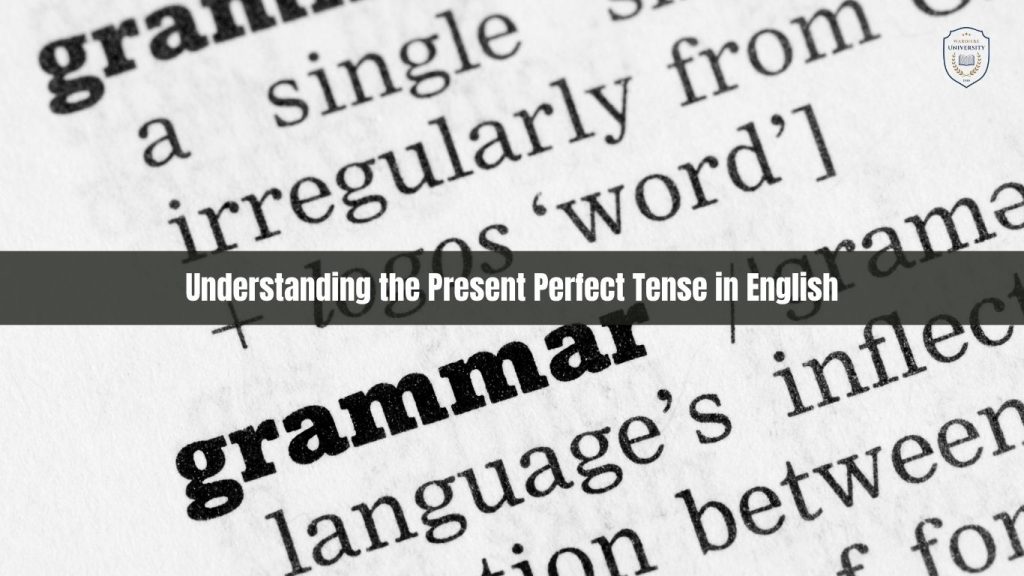The Present Perfect tense is a key grammatical structure in English that links past actions to their current relevance. Formed with “have” or “has” plus the past participle, it is used to express experiences, changes, achievements, and ongoing situations. Mastery of this tense helps learners narrate events naturally and effectively in both spoken and written communication.
Structure of the Present Perfect Tense
The Present Perfect tense in English is an essential grammatical form used to express actions or events that have relevance or connection to the present moment. Its structure is straightforward, yet highly functional, allowing speakers to link past actions to the current context.
Formula:
The formula for constructing the Present Perfect tense is as follows:
– Subject + have/has + past participle
This formula utilizes an auxiliary verb (“have” or “has”) combined with the past participle form of the main verb. The choice between “have” and “has” depends on the subject of the sentence:
– “Have” is used with the pronouns I, you, we, they, and plural nouns.
– Example: “They have completed their homework.”
– “Has” is used with the pronouns he, she, it, and singular nouns.
– Example: “She has finished her assignment.”
The past participle is a specific form of the verb, often formed by adding -ed to regular verbs (like “worked” or “played”). However, irregular verbs have unique past participles that must be memorized, such as “gone” (go), “done” (do), and “written” (write).
Importance in Language Use
Understanding and correctly applying the Present Perfect tense is crucial for conveying ongoing relevance or for describing actions that have occurred at some indefinite point in the past. This tense is a cornerstone of English fluency, providing speakers with a tool to discuss experiences and changes with precision and clarity. It forms the backbone of many conversations, especially those centered on personal experiences or professional developments, making it invaluable for effective communication.
Usage of the Present Perfect Tense
The Present Perfect tense functions as a flexible English grammatical structure which lets speakers describe past actions that maintain their relevance to the present moment. Speakers use this tense to express different time connections between past events and current moments. The Present Perfect tense serves three main purposes which become clear through the following examples.
1. Indefinite Past:
– The indefinite past tense functions to describe events which took place at any time before the current moment. The exact moment does not matter.
– Example: “I have visited Paris.”
– Explanation: The speaker explains that they have been to Paris before although they do not mention when exactly this happened because the timing details do not matter in this context.
2. Experience:
– Purpose: Utilized to discuss life experiences, often when sharing personal history or cumulative activities up to the present.
– Example: “She has traveled to several countries.”
– Explanation: The sentence shows that the person has traveled to different places but it does not mention when these trips took place because it focuses on the total number of visited places.
3. Change Over Time:
– Purpose: Shows how something has undergone changes during a specific time period to demonstrate its growth or alteration.
– Example: “He has become more confident.”
– Explanation: The sentence shows that confidence has increased during a period of time which continues to affect the current situation.
4. Achievements:
– Purpose: Used to talk about finished work or accomplishments by focusing on the final outcome of the task.
– Example: “They have completed the project.”
– Explanation: The project completion stands out as an important accomplishment although the time needed to finish the work remains undisclosed.
5. Unfinished Past:
– Purpose: Describes actions that started in the past and are still continuing into the present.
– Example: “We have lived here for ten years.”
– Explanation: The sentence shows that the person has been living in the same place since the past and continues to do so at present.
6. Multiple Actions at Different Times:
– Purpose: Shows that multiple activities occurred at various times but does not list specific dates.
– Example: “I have read three books this month.”
– Explanation: The speaker employs present perfect tense to show that they have finished reading multiple books during a specific time frame while focusing on the total number of books rather than individual reading experiences.
English learners need the Present Perfect tense to express past events which maintain their connection to the current moment. People learn to express their experiences and results and ongoing actions through proper use of this tense. The learners will boost their ability to speak and tell stories by studying these applications which will lead to better communication results. The Present Perfect tense functions as a bridge between past and present events which helps people share information about their travel history or their current work progress.
Examples of the Present Perfect Tense in Use
The Present Perfect tense functions as a core element of English grammar which shows past actions or events that happened at unknown times and maintain ties to current moments. The following examples display various ways to apply this method.
1. Completed Action with Present Relevance:
– Example: “I have already eaten lunch.”
– Explanation:The sentence reveals that the person finished their lunch at an unknown time before the current moment. The speaker uses “already” to show that the action has finished before the current time or what was expected.
2. Ongoing State or Relationship:
– Example: “She has known him for a long time.”
– Explanation:The example shows a relationship which started in the past and continues to exist at present. The phrase “for a long time” establishes that they have known each other for a long period which continues to the present time.
3. Recent Action with Immediate Relevance:
– Example: “They have just arrived at the airport.”
– Explanation:The sentence shows that the arrival happened right before now so the present moment becomes important. This use of the Present Perfect tense is particularly effective in conveying actions that impact the present or require immediate attention or response.
This tense functions as a flexible tool in English according to these examples. Speakers use this tense to express finished actions and ongoing connections and recent occurrences because it enables them to link past events to current moments in an organized and significant manner. This tense knowledge allows people to create better communication which produces more understandable stories in both spoken and written forms. Students who grasp this grammatical pattern will produce more accurate and fluid expressions of their life experiences and observations which drives effective communication in personal and professional relationships.
Conclusion
as language specialist, use industry terms of have, rewrite as one Conclusion The Present Perfect tense is a vital tool in English that connects past events to present circumstances. It enables speakers to describe life experiences, achievements, ongoing situations, and repeated actions. Mastering this tense enhances storytelling, improves clarity in communication, and deepens social interactions in both personal and professional contexts.
Keywords:
- Present perfect continuous
- Present Perfect là gì
- Present perfect examples
- Present perfect simple
- Present perfect exercise
- Present perfect tense formula
- Present perfect worksheet
- Present Perfect Wordwall
Related:
Sources:
- American Psychological Association. (2020). Publication manual of the American Psychological Association (7th ed.).
- American Psychological Association. (n.d.). Verb tense.
- University of Arizona Writing Skills Improvement Program. (2023). Tips for using verb tenses in academic writing


 Tiếng Việt
Tiếng Việt